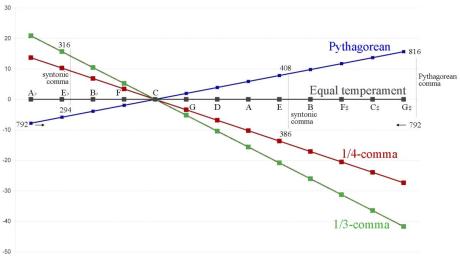Rockové klávesy - Různé systémy ladění - část 2

Greetings, readers! Welcome to another installment of Rock Keyboards. Last month we discussed a few tuning systems, namely, Pythagorean tuning and Well Temperament, and discussed a little about the history of tuning and the interesting mathematical principles involved. This month I have a few more for you. Let's dive right in.
Just or pure intonation
Just Intonation, sometimes called Pure Intonation, tunes intervals as whole number ratios (3 : 2 or 4 :3 for example) of frequencies. An interval
tuned in this way is considered a Just Interval. Just intervals, and chords created by combining them, consist of members of a single harmonic series based off a fundamental pitch. For example, G below middle C are both members of the harmonic series of the lowest C and their frequencies will be 3 and 4 times the fundamental frequency; a ratio of 4 : 3. If the frequency of the fundamental is 50 Hz the frequencies of the two notes in question would be 150 and 200. Unaccompanied vocal groups sound amazing when they use just Intonation to tune their performances.

Meantone tuning
This tuning system was created to be an improvement on the Pythagorean system. It made the third sound very sweet and smooth and became popular in the latter part of the 16th century. Classical composer, Frederic Handel loved the system. The method of meantone tuning is to slightly detune the 5th to make the 3rd sound better. The most common type of meantone temperament flats the 5th by 1/4 of the syntonic comma. This means the two notes have a frequency ratio of 80 : 81 or 5.377 cents. We call this system 1/4-comma meantone tuning. The minor third is also flattened in this way. Meantone tuning has a slight problem in the fact that it produces something called a “wolf interval”. If you stack 12 5ths from Eb; Eb-Bb-F-C-G-D-A-E-B-F#-C#-G# in meantone temperament, the G# and Eb will sound out of tune. The more the 5ths are tempered the greater and more out of tune the wolf interval will be.
Kirnberger and Werckmeister tuning
These two systems were used during the time of Bach and Beethoven to try to improve upon the problems of meantone tuning. It’s also used in modern times to tune harpsichords for baroque and classical period music. Johann Philipp Kirnberger was a student of Bach. His method was to split the wolf between two intervals. He did this by keeping three perfect 3rds and tuning the rest slightly wider (22 cents) to keep the rest of the 5ths pure. Kimberger actually developed three versions of his system in an attempt to get the 5th interval to his liking. Andreas Werckmeister actually had four versions of his system which is slightly similar in approach to Kimberger’s. In his system each of the 5ths are tempered by a 1/4 comma. This eliminated the wolf interval and made the major 3rds around 400 cents. This method started to get close to the sound of well temperament and, as such, all 12 notes can be used as tonic.
Slovníček frází a hudebního žargonu
Vážení čtenáři, v dnešním vydání Rockových kláves pokračujeme druhým dílem v zajímavém a důležitém tématu ladění. V hledáčku tentokrát uvízlo následujících pět výrazů a spojení a mně nezbývá než vám popřát příjemné a poučné čtení.
Namely: Slovo „name“ budou notoricky znát i neangličtináři, protože se s ním setkáváme na různých formulářích a víme, že „name“ znamená jméno. Pokud v angličtině přidáme za podstatné jméno příponu -ly, získáme příslovce. „Namely“ doslovně znamená jmenovitě, volně bychom mohli použít i hlavně. V článku slovíčko najdeme ve větě „Last month we discussed a few tuning systems, namely, Pythagorean tuning and well temperament, and discussed a little about the history of tuning and the interesting mathematical principles involved.“, kterou přeložíme takto: „Minulý měsíc jsme probírali několik systémů ladění, hlavně Pythagorejské a temperované ladění, a řekli si také něco o historii a zajímavých použitých matematických principech.“
Let’s dive right in: Blíží se léto a s ním, doufejme, už konečně také návrat do normálu, a tedy doba dovolených. A k nim patří i různé sporty a zážitky. Některé si můžeme užít i v českých končinách, ale lépe si je vychutnáme u moře. Například potápění. Ve vybraném výrazu z Rockových kláves to je slovo „dive“. „Dive in“ znamená ponořit se (do něčeho). Věta „Let-s dive right in“ by šla přeložit i volněji jako „Pojďme rovnou na to.“ nebo „Pojďme se do toho hned vrhnout.“.
Just or pure intonation: Čisté nebo přirozené ladění. V těchto systémech ladění jsou intervaly mezi tóny vyjádřeny stejným poměrem (číslem). Do této skupiny mimo jiné patří Pythagorejské ladění.
Latter (part): Tady může snadno dojít k záměně s jiným, více frekventovaným výrazem, slovíčkem „later“, které znamená později. „Latter“ je výraz britské angličtiny, Američan by zřejmě použil spíše slovíčko „second“, čímž už naznačuji, co slovo „latter“ znamená. Vyjadřujeme tím druhou (poslední) ze dvou věcí. V článku je ve větě „... became popular in the latter part of the 16th century.“, kterou přeložíme „... a stalo se (ladění) populárním v druhé polovině šestnáctého století.“.
Upon: Je takové trochu formálnější slovo, v běžné řeči na něj tolik nenarazíme. Je to předložka, do češtiny se překládá obyčejně jako „na“, stejně jako běžnější anglická předložka „on“. Používá se zejména s vybranými slovesy, včetně frázových, ale může i překvapit, protože jeden z významů se vztahuje k času, například „upon arrival“, bychom nepřekládali „na příjezdu“, ale „(ihned) po příjezdu“. V článku je slovo ve větě: „... to try to improve upon the problems of Meantone Tuning.“, kde reprezentuje význam zlepšení něčeho, co už bylo předtím uděláno, tedy: „... ve snaze lépe vyřešit problémy temperovaného ladění.“.




